HONDA PRELUDE 2000 Owner's Manual (in English)
Manufacturer: HONDA, Model Year: 2000, Model line: PRELUDE, Model: HONDA PRELUDE 2000Pages: 293, PDF Size: 3.43 MB
Page 241 of 293
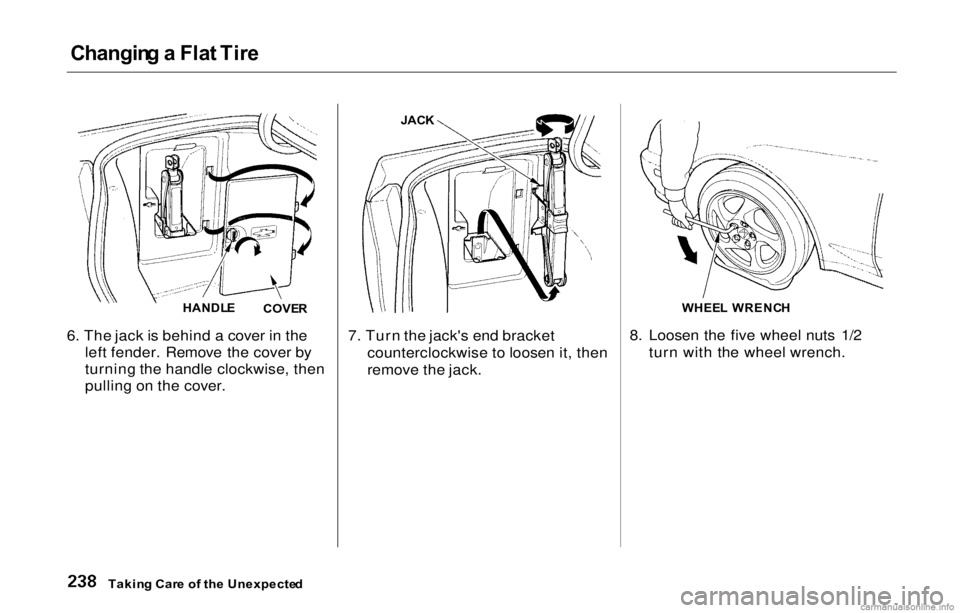
Changing a Fla t Tir e
6. The jack is behind a cover in the
left fender. Remove the cover by
turning the handle clockwise, then
pulling on the cover. 7. Turn the jack's end bracket
counterclockwise to loosen it, then
remove the jack. 8. Loosen the five wheel nuts 1/2
turn with the wheel wrench.
Takin g Car e o f th e Unexpecte d
HANDLECOVERWHEE L WRENC H
JACK
Page 242 of 293
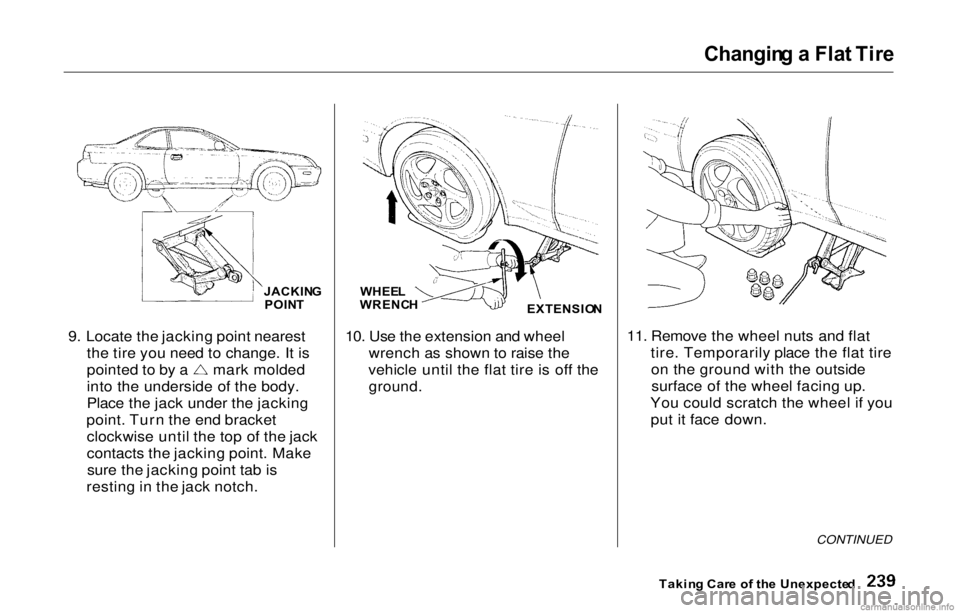
Changin
g a Fla t Tir e
9. Locate the jacking point nearest the tire you need to change. It is pointed to by a mark molded
into the underside of the body.
Place the jack under the jacking
point. Turn the end bracket clockwise until the top of the jack
contacts the jacking point. Makesure the jacking point tab is
resting in the jack notch. 10. Use the extension and wheel
wrench as shown to raise the
vehicle until the flat tire is off the
ground.
11. Remove the wheel nuts and flat
tire. Temporarily place the flat tireon the ground with the outsidesurface of the wheel facing up.
You could scratch the wheel if you put it face down.
CONTINUED
Takin g Car e o f th e Unexpecte d
JACKIN
G
POIN T
WHEE
L
WRENC H
EXTENSION
Page 243 of 293
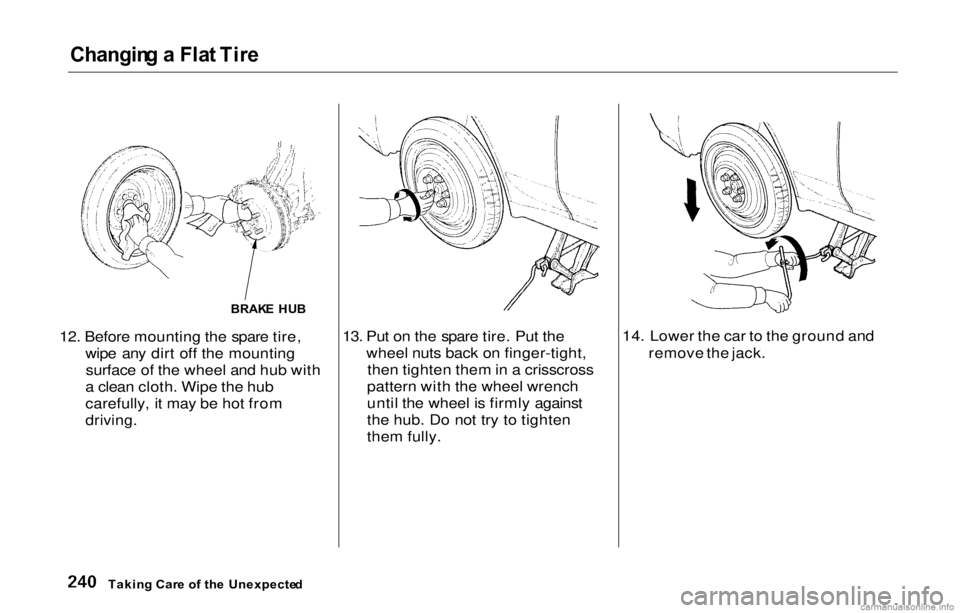
Changing a Fla t Tir e
12. Before mounting the spare tire,
wipe any dirt of f th
e mounting
surface of the wheel and hub with
a clean cloth. Wipe the hub
carefully, it may be hot from
driving.
13. Put on the spare tire. Put the wheel nuts back on finger-tight ,
then tighten them in a crisscross
pattern with the wheel wrench
until the wheel is firmly against
the hub. Do not try to tighten
them fully. 14. Lower the car to the ground and
remove the jack.
Takin g Car e o f th e Unexpecte d
BRAKE HU B
Page 244 of 293
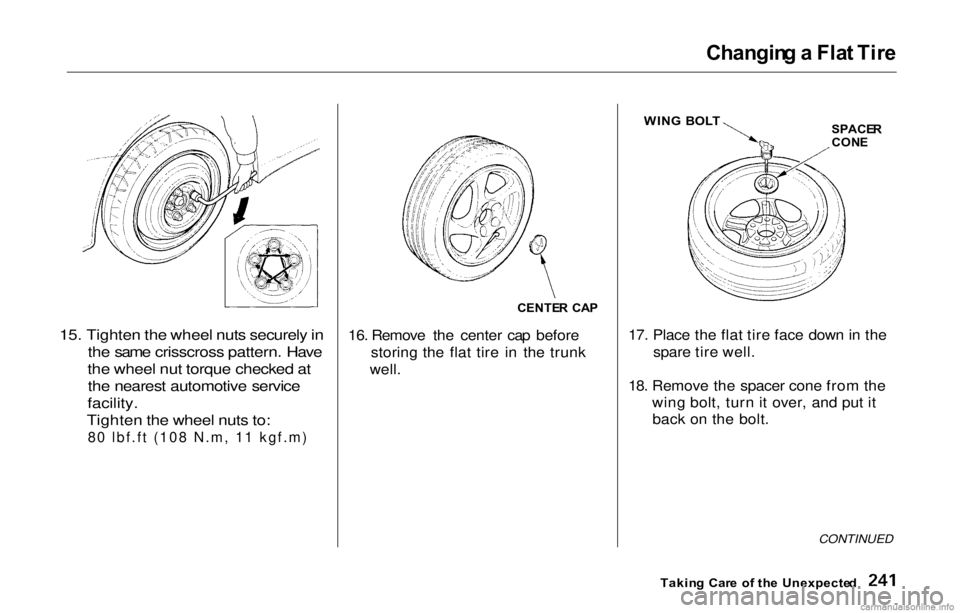
Changing a Fla t Tir e
15. Tighten the wheel nuts securely in
the same crisscross pattern. Hav
e
the wheel nut torque checked at the nearest automotive service
facility.
Tighten the wheel nuts to:
80 lbf.ft (108 N.m, 11 kgf.m)
16. Remove the center cap before storing the flat tire i n the trunk
well. 17. Place the flat tire face down in the
spare tire well.
18. Remove the spacer cone from the wing bolt, turn it over, and put itback on the bolt.
CONTINUED
Takin g Car e o f th e Unexpecte d
WIN
G BOL T
SPACE R
CON E
CENTE R CA P
Page 245 of 293
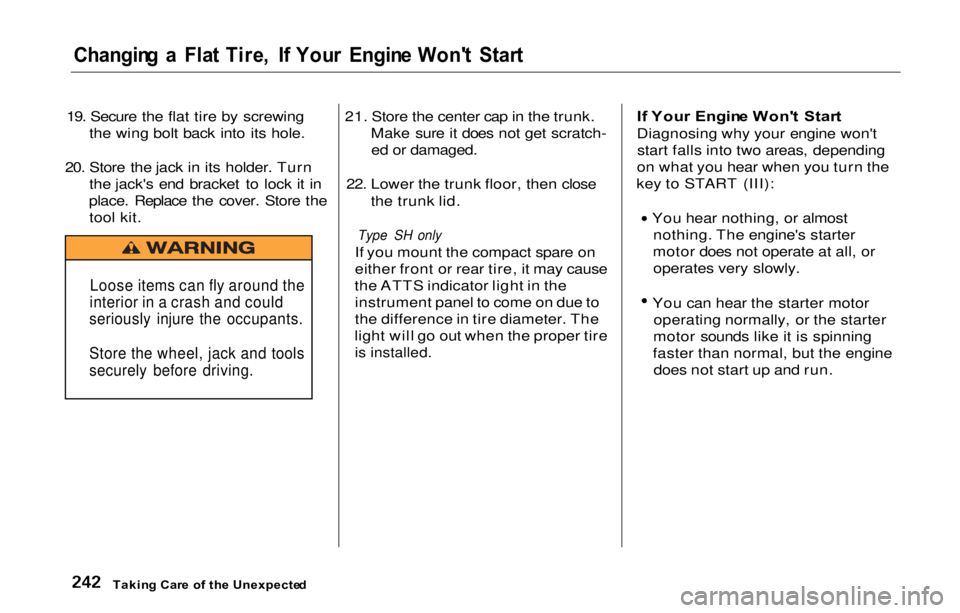
Changing a Fla t Tire , I f You r Engin e Won' t Star t
19. Secure the flat tire by screwing
the wing bolt back into its hole.
20. Store the jack in its holder. Turn the jack's end bracket to lock it in
place. Replace the cover. Store the tool kit. 21. Store the center cap in the trunk.
Make sure it does not get scratch-ed or damaged.
22. Lower the trunk floor, then close the trunk lid.
Type SH only
If you mount the compact spare on
either front or rear tire, it may cause
the ATTS indicator light in the instrument panel to come on due to
the difference in tire diameter. The
light will go out when the proper tire
is installed.
I f You r Engin e Won' t Star t
Diagnosing why your engine won't start falls into two areas, depending
on what you hear when you turn the
key to START (III):
You hear nothing, or almost nothing. The engine's starter
motor does not operate at all, or operates very slowly.
You can hear the starter motor operating normally, or the starter
motor sounds like it is spinning
faster than normal, but the engine does not start up and run.
Takin g Car e o f th e Unexpecte d
Loose items can fly around the
interior in a crash and could
seriously injure the occupants.
Store the wheel, jack and tools
securely before driving.
Page 246 of 293
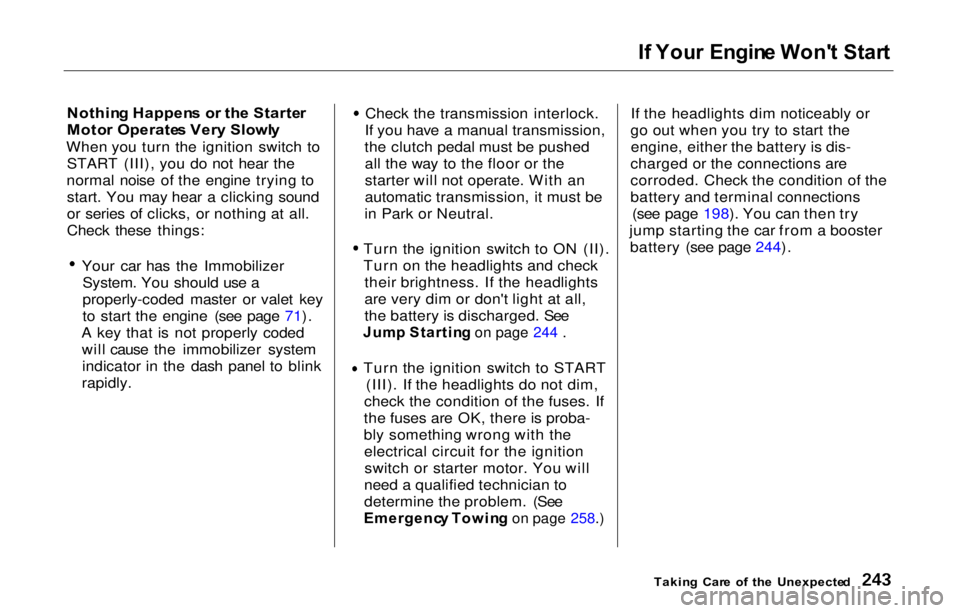
I
f You r Engin e Won' t Star t
Nothin g Happen s o r th e Starte r
Moto r Operate s Ver y Slowl y
When you turn the ignition switch to START (III), you do not hear the
normal noise of the engine trying to start. You may hear a clicking sound
or series of clicks, or nothing at all.
Check these things: Your car has the Immobilizer
System. You should use a
properly-coded master or valet key
to start the engine (see page 71).
A key that is not properly coded will cause the immobilizer systemindicator in the dash panel to blink
rapidly. Check the transmission interlock.
If you have a manual transmission,
the clutch pedal must be pushed all the way to the floor or the
starter will not operate. With an
automatic transmission, it must be
in Park or Neutral. Turn the ignition switch to ON (II).
Turn on the headlights and check
their brightness. If the headlights
are very dim or don't light at all,
the battery is discharged. See
Jum p Startin g on page 244 .
Turn the ignition switch to START
(III). If the headlights do not dim,
check the condition of the fuses. If
the fuses are OK, there is proba-
bly something wrong with the electrical circuit for the ignitionswitch or starter motor. You will
need a qualified technician to
determine the problem. (See
Emergenc y Towin g on page 258.)
If the headlights dim noticeably or
go out when you try to start the engine, either the battery is dis-
charged or the connections are
corroded. Check the condition of the
battery and terminal connections (see page 198). You can then try
jump starting the car from a booster battery (see page 244).
Takin g Car e o f th e Unexpecte d
Page 247 of 293
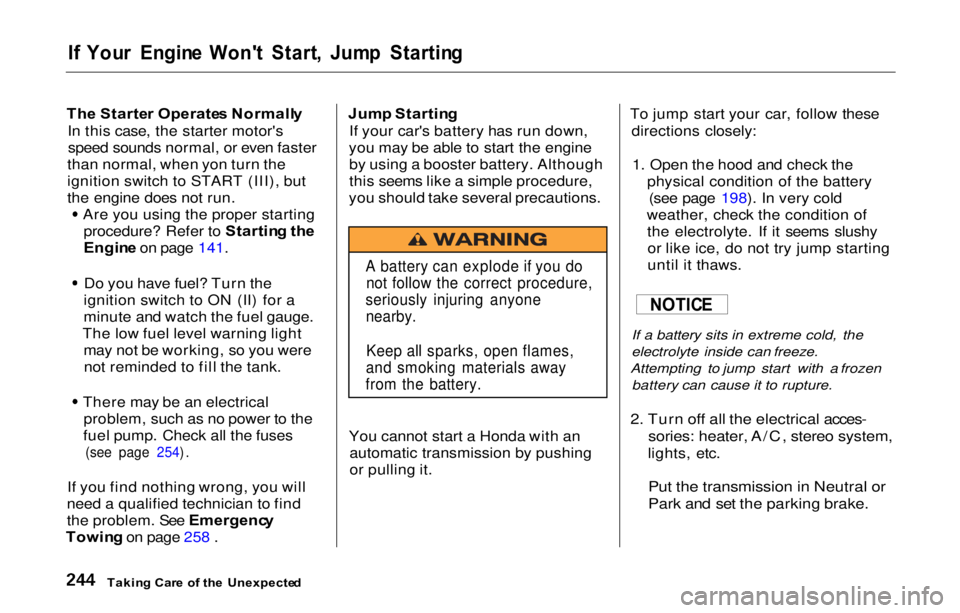
If You r Engin e Won' t Start , Jum p Startin g
The Starte r Operate s Normall y
In this case, the starter motor's speed sounds normal, or even faster
than normal, when yon turn the
ignition switch to START (III), but
the engine does not run.
Are you using the proper starting procedure? Refer to Startin g th e
Engin e on page 141.
Do you have fuel? Turn the
ignition switch to ON (II) for a
minute and watch the fuel gauge.
The low fuel level warning light may not be working, so you werenot reminded to fill the tank.
There may be an electrical problem, such as no power to the
fuel pump. Check all the fuses
(see page 254).
If you find nothing wrong, you will
need a qualified technician to find
the problem. See Emergenc y
Towin g on page 258 . Jum
p Startin g
If your car's battery has run down,
you may be able to start the engine by using a booster battery. Although
this seems like a simple procedure,
you should take several precautions.
You cannot start a Honda with an automatic transmission by pushing
or pulling it. To jump start your car, follow these
directions closely:
1. Open the hood and check the physical condition of the battery(see page 198). In very cold
weather, check the condition of the electrolyte. If it seems slushyor like ice, do not try jump starting
until it thaws.
If a battery sits in extreme cold, the
electrolyte inside can freeze.
Attempting to jump start with a frozen
battery can cause it to rupture.
2. Turn off all the electrical acces-
sories: heater, A/C, stereo system,
lights, etc.
Put the transmission in Neutral or
Park and set the parking brake.
Takin g Car e o f th e Unexpecte d
A battery can explode if you do
not follow the correct procedure,
seriously injuring anyone nearby.
Keep all sparks, open flames,
and smoking materials away
from the battery.
NOTIC E
Page 248 of 293
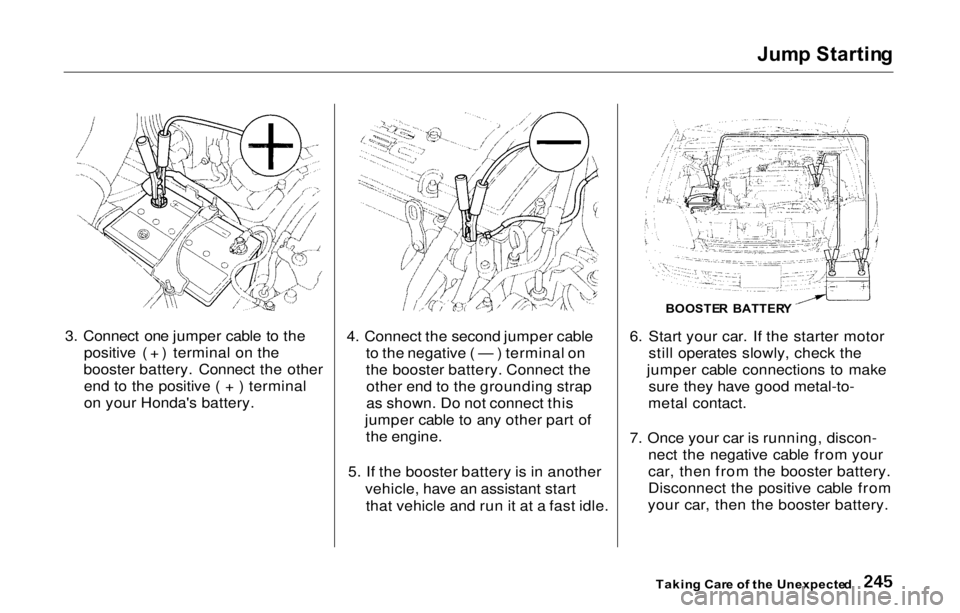
Jum
p Startin g
3. Connect one jumper cable to the positive ( + ) terminal on the
booster battery. Connect the other end to the positive ( + ) terminal
on your Honda's battery. 4. Connect the second jumper cable
to the negative ( — ) terminal on
the booster battery. Connect theother end to the grounding strap
as shown. Do not connect this
jumper cable to any other part of the engine.
5. If the booster battery is in another vehicle, have an assistant startthat vehicle and run it at a fast idle. 6. Start your car. If the starter motor
still operates slowly, check the
jumper cable connections to make sure they have good metal-to-
metal contact.
7. Once your car is running, discon- nect the negative cable from your
car, then from the booster battery.
Disconnect the positive cable from
your car, then the booster battery.
Takin g Car e o f th e Unexpecte d
BOOSTE
R BATTER Y
Page 249 of 293
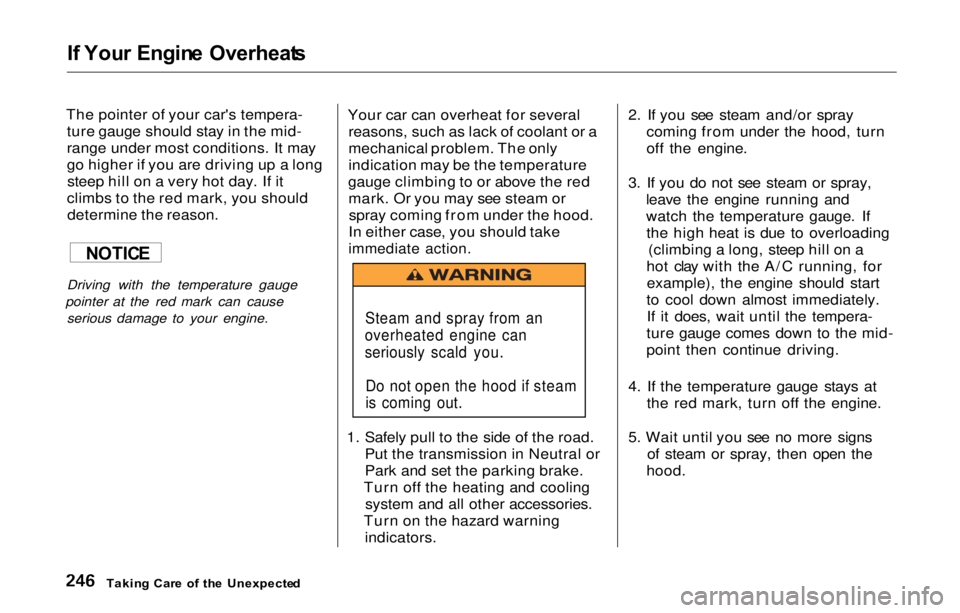
If You r Engin e Overheat s
The pointer of your car's tempera-
ture gauge should stay in the mid-
range under most conditions. It may
go higher if you are driving up a longsteep hill on a very hot day. If it
climbs to the red mark, you should determine the reason.
Driving with the temperature gauge
pointer at the red mark can cause serious damage to your engine.
Your car can overheat for severalreasons, such as lack of coolant or a
mechanical problem. The only
indication may be the temperature
gauge climbing to or above the red mark. Or you may see steam orspray coming from under the hood.
In either case, you should take
immediate action.
1. Safely pull to the side of the road. Put the transmission in Neutral or
Park and set the parking brake.
Turn off the heating and cooling system and all other accessories.
Turn on the hazard warning indicators. 2. If you see steam and/or spray
coming from under the hood, turn
off the engine.
3. If you do not see steam or spray, leave the engine running and
watch the temperature gauge. Ifthe high heat is due to overloading (climbing a long, steep hill on a
hot clay with the A/C running, for example), the engine should start
to cool down almost immediately. If it does, wait until the tempera-
ture gauge comes down to the mid-
point then continue driving.
4. If the temperature gauge stays at the red mark, turn off the engine.
5. Wait until you see no more signs of steam or spray, then open the
hood.
Takin g Car e o f th e Unexpecte d
NOTICE
Steam and spray from an
overheated engine can
seriously scald you.
Do not open the hood if steam
is coming out.
Page 250 of 293

I
f You r Engin e Overheat s
6. Look for any obvious coolant leaks, such as a split radiator hose.
Everything is still extremely hot, so use caution. If you find a leak, it
must be repaired before you
continue driving (see Emergenc y
Towin g on page 258).
7. If you don't find an obvious leak, check the coolant level in the
radiator reserve tank (see page131). If the level is below the
MIN mark, add coolant to halfway
between the MIN and MAX marks.
8. If there was no coolant in the reserve tank, you may also have toadd coolant to the radiator. Let the
engine cool down until the pointer
reaches the middle of the tempera-
ture gauge, or lower, before check- ing the radiator. 9. Using gloves or a large heavy
cloth, turn the radiator cap
counterclockwise, without pushing
down, to the first stop. This
releases any remaining pressure in
the cooling system. After the
pressure releases, push down on
the cap and turn it until it comes off. 10. Start the engine and set the
temperature control lever tomaximum. Add coolant to the
radiator up to the base of the filler
neck. If you do not have the
proper coolant mixture available,
you can add plain water. Remember to have the coolingsystem drained and refilled with
the proper mixture as soon as you
can.
11. Put the radiator cap back on tightly. Run the engine and watchthe temperature gauge. If it goes
back to the red mark, the engine
needs repair. (See Emergenc y
Towin g on page 258.)
12. If the temperature stays normal, check the coolant level in the
radiator reserve tank. If it has
gone down, add coolant to the MAX mark. Put the cap back on
tightly.
Takin g Car e o f th e Unexpecte d
Removing the radiator cap
while the engine is hot can cause the coolant to spray out,
seriously scalding you.
Always let the engine and radiator cool down before
removing the radiator cap.